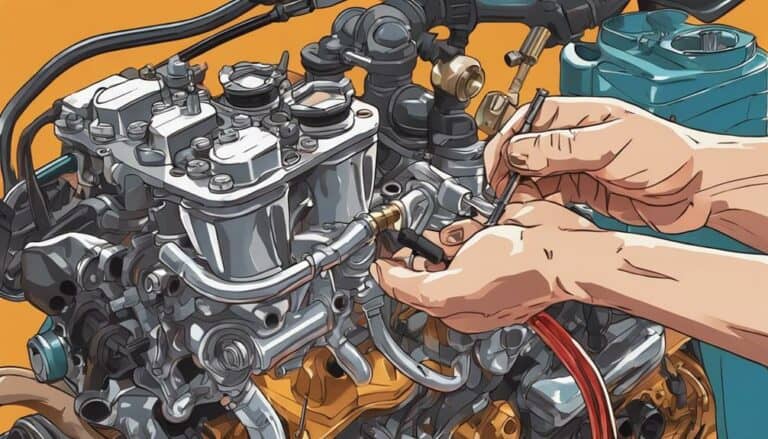Adjusting the carburetor on a four-stroke dirt bike engine may seem intimidating at first, but with a few simple steps, you can easily fine-tune your bike's performance.
By understanding the basics of carb adjustment, you can optimize your engine's efficiency and responsiveness.
Let's explore the key techniques for adjusting your four-stroke dirt bike engine carb to make sure it runs smoothly and delivers the performance you desire.
Key Takeaways
- Identify carb components and settings for optimal performance.
- Adjust air-fuel mixture and idle speed accurately.
- Use precision tools for fine-tuning and peak engine performance.
- Troubleshoot irregularities and ensure smooth throttle response.
Tools Required for Carb Adjustment
To properly adjust the carburetor on your four-stroke dirt bike engine, you'll need an array of essential tools to guarantee precision and accuracy in the tuning process. When dealing with the carburetor on a two-stroke engine, having the right tools is vital for achieving peak performance. Essential tools include a flat-head screwdriver and a Phillips screwdriver for adjusting various screws, jetting tools for fine-tuning the fuel mixture, and a carburetor cleaner to make certain the carb is free of any obstructions.
In addition to these basic tools, specific carb adjustment tools like a carburetor synchronizer or vacuum gauge may be necessary for more precise adjustments. A clean work area with good lighting is essential for seeing all the intricate components during the tuning process. It's also advisable to have the service manual for your specific dirt bike model on hand as it provides detailed instructions for carb adjustment procedures.
Using a digital tachometer can aid in setting the correct idle speed, a critical step in the carburetor adjustment process.
Locating the Carburetor on Your Bike
Positioned near the engine intake, you can typically find the carburetor on your four-stroke dirt bike. To locate this important component for carburetor maintenance, troubleshooting tips, and potential performance upgrades, follow these steps:
- Visual Inspection: Look for a device with an air intake, fuel inlet, and throttle linkage. The carburetor is commonly situated on the side or top of the engine, varying based on your bike's make and model.
- Component Removal: Accessing the carburetor may require removing the seat, side panels, or other parts obstructing your view. Clear visibility is key for performing adjustments accurately.
- Best Settings: Locating the carburetor is essential for adjusting the idle, fuel mixture, and other settings important for peak engine performance. Understanding its placement ensures you can fine-tune your bike effectively.
Adjusting the Air-Fuel Mixture
When adjusting the air-fuel mixture on your four-stroke dirt bike engine carb, locate the fuel screw on the carburetor. Use a screwdriver to turn the fuel screw clockwise to lean out the mixture or counterclockwise to enrich it.
Tuning techniques involve starting the bike and letting it idle, then adjusting the fuel screw gradually until you achieve a smooth and consistent idle. This adjustment is important for best engine performance and throttle response, leading to potential performance gains.
Properly fine-tuning the air-fuel mixture guarantees efficient combustion, preventing issues like backfiring or stalling. Troubleshooting tips include paying attention to the sound of the engine and exhaust, as well as monitoring for any irregularities in performance.
Setting the Idle Speed
For best performance of your four-stroke dirt bike engine, locating the idle adjustment screw on the carburetor is essential. Adjusting the idle speed correctly is critical for a smooth engine operation. Here's how to set the idle speed effectively:
- Common Mistakes
- Avoid setting the idle speed too high, as it can cause the engine to overheat and lead to premature wear.
- Don't overlook the importance of warming up the engine before adjusting the idle speed, as this can affect the accuracy of the setting.
- Troubleshooting Tips
- If the engine idles erratically or stalls frequently, check for air leaks in the intake system or a dirty air filter before adjusting the idle speed.
- Expert Recommendations
- Fine-tune the idle speed within the manufacturer's recommended RPM range, typically between 1200-1800 RPM, for optimal performance and responsiveness.
- Ensure the idle speed is set accurately for a seamless throttle response and to prevent stalling during your rides.
Fine-Tuning for Optimal Performance
To enhance the performance of your four-stroke dirt bike engine, meticulous fine-tuning of key components is essential. Performance tuning involves optimizing the carburetor settings to make sure your engine operates at its peak.
Start by using a tachometer to set the idle speed according to the manufacturer's recommendations. Adjust the fuel screw incrementally to achieve a smooth idle and responsive throttle. Check the hot start lever's functionality to facilitate easy warm engine starts.
Inspect for air leaks near the carburetor, as these can impact idle quality and overall engine performance. Fine-tune the idle mixture by listening to the engine's sound and making precise adjustments for the ideal fuel-to-air ratio.
Conclusion
Now that you have adjusted the carburetor on your four-stroke dirt bike engine, you're ready to hit the trails with confidence.
Just like tuning an instrument for a perfect performance, tuning your carburetor guarantees your bike runs smoothly and efficiently.
With the right adjustments, you'll experience peak throttle response and a better overall riding experience.
So, get out there and enjoy the ride!

